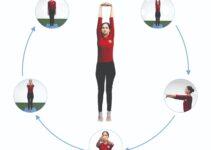What is a monkey pose?
- Monkey pose yoga is the English name of Hanumanasana, a Sanskrit word derived from Hanuman.
- I have seen a few of my senior yoga teachers fond of practising this yoga pose regularly. Even at the age of sixty-plus, their facial complexions are beaming. It might be the impact of these yoga poses.
- It is a yoga pose known for greater flexibility.
- Hanumanasana is pronounced as hah-new-mahn-AHS-anna.
- It is the split. In yoga, it is performed with closed hips, while in gymnastics, it is done with open hips. However, in yoga, the focus is also given to breathing.

Eight amazing benefits of monkey pose
Here, we will focus on the health benefits of the monkey pose.
- Reversing the signs of ageing: We have been taught in yoga classes that flexibility is indirectly proportional to ageing. This means more flexibility ensures slowing down the ageing process. The monkey pose gives the highest level of flexibility to the body. At the same time, it facilitates better breathing and decreases stress.
- Prevent sexual problems: The practising of the Hanumanasana affects the reproductive organs, viz. ovary and testes. It also gives flexibility to these body parts and provides better-oxygenated blood to the sexual organs.
- Ensure easy labour: The yoga pose requires extra practice to reach the final pose. However, if it is practised under the supervision of a yoga teacher, the pregnant mother can benefit. The yoga pose method helps massage the perineum and ensure proper breathing for the mother.
- Relieve stress: It provides adequate stretching to the body, thus removing stiffness from the muscles and nerves and thereby helpful in overcoming stress and tension. It also helps in eliminating toxins from the body.
- Smooth digestion: The monkey pose stimulates the abdominal organs. It helps in the secretion of gastric juices and strengthens the digestive organs. It enhances the efficiency of these organs, is good for digestion, and prevents constipation.
- Yoga for flexibility: Yoga poses are known for flexibility. This is one of the best yoga poses to provide further flexibility to the hips, thighs, hamstrings, groins and legs. Thus, it will be beneficial in curing knee pain and muscular leg weakness.
- Remove back pain: It helps make the lower spine supple and flexible. It also strengthens the lower back.
- Muscle strength: It has been shown through research that the practice of this split helps to improve muscle strength, muscle endurance, flexibility, and agility. Besides removing muscle weakness, it also reduces the stiffness of the body.
Top 5 Facts about Monkey Pose
- The name has been taken from Hindu mythology. Hanuman rescued Sita, Bhagwan Ram’s wife. Sita was made captive on the island of Sri Lanka, and lord Hanuman made huge splits between the southern tip of India and Sri Lanka to save her.
- In Sanskrit, it is known as Hanumanasana (hah-new-mahn-AHS-anna). It is also known as splits.
- It is a seated pose wherein the maximum thrust is experienced on the lower parts of the body.
- Hanumanasana means Hanuman-‘Lord Hanuman’ and asana indicates to yoga pose.
- The actively involved muscles are the Psoas major, Quadriceps, Rectus femoris and Hamstrings.
Breathing
You’ll know you’re doing this pose effectively when you can breathe freely. Until all the flexion, extension, and rotational forces have been neutralised, and the spine can extend easily, breathing will be difficult and rough. The use of props such as blocks, straps, or blankets is highly recommended so that the work can be done in a gradual way that doesn’t excessively disturb the rhythm of the breath.
Contraindications
It shouldn’t be done in the following cases.
- Injury to the hamstring
- Groin injury
- Don’t exert yourself for the entire split
- Better to avoid by those who have stiff bodies.
- Slipped disc
- Sciatica
- Hernia
Precautions
- One shouldn’t try for the perfection of the pose.
- Beginners should put a cushion under the buttocks.
- Better to start the pose with the yoga teacher.






